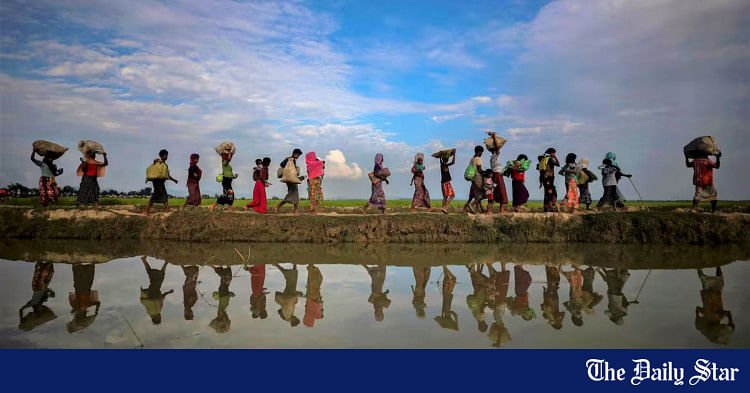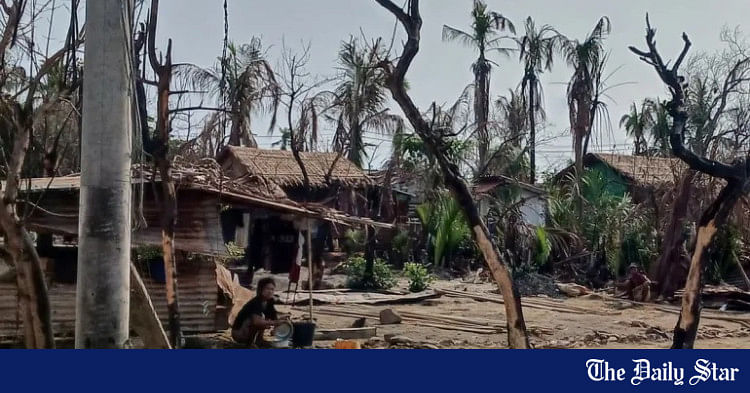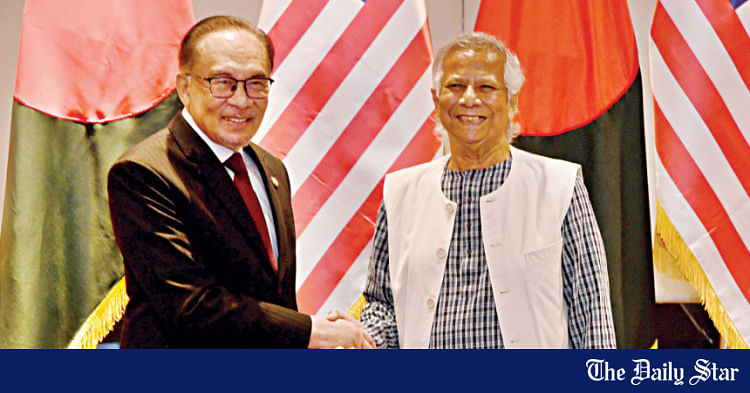Saif
Senior Member
- Messages
- 14,863
- Reaction score
- 7,675
- Origin

- Residence

- Axis Group

- Copy to clipboard
- Thread starter
- #321

Rohingya crisis threatens regional security: Yunus
Bangladesh interim government’s chief adviser Professor Muhammad Yunus at a discussion on Wednesday in Qatar’s capital Doha said that prolonged stay of Rohingyas posed enormous challenges to Bangladesh and might affect regional security and stability if the crisis lingered further...
 www.newagebd.net
www.newagebd.net
Rohingya crisis threatens regional security: Yunus
Staff Correspondent 23 April, 2025, 15:53

Chief adviser Professor Muhammad Yunus, accompanied by Qatar deputy prime minister Sheikh Saoud bin Abdulrahman bin Hassan bin Ali Al-Thani, is given a ceremonial guard of honour by Qatar armed forces in Doha on Wednesday. | PID Photo
Bangladesh interim government’s chief adviser Professor Muhammad Yunus at a discussion on Wednesday in Qatar’s capital Doha said that prolonged stay of Rohingyas posed enormous challenges to Bangladesh and might affect regional security and stability if the crisis lingered further.
Calling upon Qatar to use its good offices in creating pressure on Myanmar for repatriation of the forcibly displaced Rohingyas to their homeland, he said that unfortunately, international attention had gradually been shifting from the Rohingya crisis due to various conflicts arising at different corners of the globe.
‘If the problem persists further, it may affect the security and stability of the entire region and jeopardise development initiatives,’ Yunus said while addressing the high-level roundtable on the ‘Social and Environmental Challenges around Forcibly Displaced Populations: The Case of the Rohingya’.
He said that the Rohignya crisis was not simply a humanitarian concern, it was rather a multidimensional challenge with social, economic, political and environmental implications.
He said that rise in criminal activities in the camps and attempts of illegal migration were clear signs of desperation among them.
Yunus called upon all concerned to work together ‘for humanity, for stability and for justice’.
He said that Bangladesh was currently hosting about 1.3 million forcibly displaced Myanmar nationals while 32,000 newborns were being added yearly as none of the displaced people from the Rakhine State could be returned after the outbreak of the crisis in 2017.
‘Despite numerous challenges and constraints, Bangladesh is giving shelter to such a huge number of Rohingyas only on humanitarian considerations. Bangladesh considers sustainable repatriation as the only solution to the current crisis,’ the chief adviser said.
On the recent situation in the Rakhine State, he said that the situation there had undergone dramatic changes.
‘The Arakan Army now controls the 271-kilometre Bangladesh-Myanmar Border and 14 of Rakhine’s 17 townships. As of February 2025, Rakhine’s total internally displaced population stood at 5,38,876 individuals,’ he said, adding that among them, 1,52,071 stateless Rohingya remained in 21 protracted camps and three villages.
He said that additionally, 3,86,805 people, mostly Rakhine, were newly displaced across 1,219 different sites, reflecting the ongoing humanitarian crisis in the region.
Due to the ongoing armed conflicts in Myanmar, fresh arrivals of Rohingyas in Bangladesh since November 2023 have crossed 1,00,000, Yunus said.
‘Since February 2024, being attacked by the Arakan Army, 909 Myanmar security personnel have taken refuge inside Bangladesh of their own volition. Among them, 875 were repatriated to Myanmar, with another 34 to be repatriated soon,’ he said, adding that funding under the Joint Response Plan for the Rohingya humanitarian crisis was decreasing.
He told the roundtable that Bangladesh would organise a ‘High-Level Conference on the Situation of Rohingya Muslims and Other Minorities in Myanmar’ under UN auspices, probably in September 2025 in New York.
Bangladesh expected high-level political participation and cooperation from Qatar in the conference, the chief adviser said.
‘Qatar can use its good offices to put pressure on Myanmar for starting the repatriation of Rohingya people without any further delay,’ Yunus said.
Underlining the need for a meaningful partnership, he said that given the renewed international geopolitical and geostrategic scenario, Qatar could strongly express its solidarity to resolve the issue and be proactive to engage the Organisation of Islamic Cooperation countries to raise more funds and impose pressure on the international community to advocate for the repatriation of the Rohingyas.
Yunus and Qatar Foundation chief executive officer Sheikha Hind bint Hamad Al Thani, also sister of Qatar Amir, and the host of Earthna Summit, joined the roundtable, the United News of Bangladesh reported from Doha.
As of March 19, out of the data of a total of 8,29,036 submitted by the Bangladesh government, as many as 2,39,056 people were verified by the Myanmar government, and among them, 1,76,198 people were cleared as ‘Persons who resided in Myanmar’ by the government of Myanmar, the UNB report mentioned.
Qatar was among the first few countries to immediately provide assistance and support after the onset of the Rohingyas crisis in 2017, the chief adviser mentioned.
He said the ongoing justice and accountability initiatives in the International Court of Justice, the investigation of the International Criminal Court, and the activities of the Independent Investigative Mechanism for Myanmar regarding the atrocities committed against Rohingyas were very crucial.
Bangladesh as state party of the UN and Rome Statute, he said, strongly believes crimes like genocide and crime against humanity should never go unpunished.
‘Attributing the crimes to Myanmar/officials of Myanmar will also be a crucial tool to build the confidence of Rohingyas for their repatriation to Rakhine,’ said the chief adviser.
Bangladesh foreign affairs adviser Md Touhid Hossain, energy adviser Fouzul Kabir Khan, national security adviser and high representative to chief adviser Khalilur
Rahman, SDGs affairs principal coordinator Lamiya Morshed and Bangladesh ambassador to Qatar Md Nazrul Islam were present, among others, at the discussion.
Staff Correspondent 23 April, 2025, 15:53
Chief adviser Professor Muhammad Yunus, accompanied by Qatar deputy prime minister Sheikh Saoud bin Abdulrahman bin Hassan bin Ali Al-Thani, is given a ceremonial guard of honour by Qatar armed forces in Doha on Wednesday. | PID Photo
Bangladesh interim government’s chief adviser Professor Muhammad Yunus at a discussion on Wednesday in Qatar’s capital Doha said that prolonged stay of Rohingyas posed enormous challenges to Bangladesh and might affect regional security and stability if the crisis lingered further.
Calling upon Qatar to use its good offices in creating pressure on Myanmar for repatriation of the forcibly displaced Rohingyas to their homeland, he said that unfortunately, international attention had gradually been shifting from the Rohingya crisis due to various conflicts arising at different corners of the globe.
‘If the problem persists further, it may affect the security and stability of the entire region and jeopardise development initiatives,’ Yunus said while addressing the high-level roundtable on the ‘Social and Environmental Challenges around Forcibly Displaced Populations: The Case of the Rohingya’.
He said that the Rohignya crisis was not simply a humanitarian concern, it was rather a multidimensional challenge with social, economic, political and environmental implications.
He said that rise in criminal activities in the camps and attempts of illegal migration were clear signs of desperation among them.
Yunus called upon all concerned to work together ‘for humanity, for stability and for justice’.
He said that Bangladesh was currently hosting about 1.3 million forcibly displaced Myanmar nationals while 32,000 newborns were being added yearly as none of the displaced people from the Rakhine State could be returned after the outbreak of the crisis in 2017.
‘Despite numerous challenges and constraints, Bangladesh is giving shelter to such a huge number of Rohingyas only on humanitarian considerations. Bangladesh considers sustainable repatriation as the only solution to the current crisis,’ the chief adviser said.
On the recent situation in the Rakhine State, he said that the situation there had undergone dramatic changes.
‘The Arakan Army now controls the 271-kilometre Bangladesh-Myanmar Border and 14 of Rakhine’s 17 townships. As of February 2025, Rakhine’s total internally displaced population stood at 5,38,876 individuals,’ he said, adding that among them, 1,52,071 stateless Rohingya remained in 21 protracted camps and three villages.
He said that additionally, 3,86,805 people, mostly Rakhine, were newly displaced across 1,219 different sites, reflecting the ongoing humanitarian crisis in the region.
Due to the ongoing armed conflicts in Myanmar, fresh arrivals of Rohingyas in Bangladesh since November 2023 have crossed 1,00,000, Yunus said.
‘Since February 2024, being attacked by the Arakan Army, 909 Myanmar security personnel have taken refuge inside Bangladesh of their own volition. Among them, 875 were repatriated to Myanmar, with another 34 to be repatriated soon,’ he said, adding that funding under the Joint Response Plan for the Rohingya humanitarian crisis was decreasing.
He told the roundtable that Bangladesh would organise a ‘High-Level Conference on the Situation of Rohingya Muslims and Other Minorities in Myanmar’ under UN auspices, probably in September 2025 in New York.
Bangladesh expected high-level political participation and cooperation from Qatar in the conference, the chief adviser said.
‘Qatar can use its good offices to put pressure on Myanmar for starting the repatriation of Rohingya people without any further delay,’ Yunus said.
Underlining the need for a meaningful partnership, he said that given the renewed international geopolitical and geostrategic scenario, Qatar could strongly express its solidarity to resolve the issue and be proactive to engage the Organisation of Islamic Cooperation countries to raise more funds and impose pressure on the international community to advocate for the repatriation of the Rohingyas.
Yunus and Qatar Foundation chief executive officer Sheikha Hind bint Hamad Al Thani, also sister of Qatar Amir, and the host of Earthna Summit, joined the roundtable, the United News of Bangladesh reported from Doha.
As of March 19, out of the data of a total of 8,29,036 submitted by the Bangladesh government, as many as 2,39,056 people were verified by the Myanmar government, and among them, 1,76,198 people were cleared as ‘Persons who resided in Myanmar’ by the government of Myanmar, the UNB report mentioned.
Qatar was among the first few countries to immediately provide assistance and support after the onset of the Rohingyas crisis in 2017, the chief adviser mentioned.
He said the ongoing justice and accountability initiatives in the International Court of Justice, the investigation of the International Criminal Court, and the activities of the Independent Investigative Mechanism for Myanmar regarding the atrocities committed against Rohingyas were very crucial.
Bangladesh as state party of the UN and Rome Statute, he said, strongly believes crimes like genocide and crime against humanity should never go unpunished.
‘Attributing the crimes to Myanmar/officials of Myanmar will also be a crucial tool to build the confidence of Rohingyas for their repatriation to Rakhine,’ said the chief adviser.
Bangladesh foreign affairs adviser Md Touhid Hossain, energy adviser Fouzul Kabir Khan, national security adviser and high representative to chief adviser Khalilur
Rahman, SDGs affairs principal coordinator Lamiya Morshed and Bangladesh ambassador to Qatar Md Nazrul Islam were present, among others, at the discussion.
















